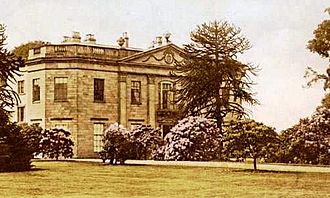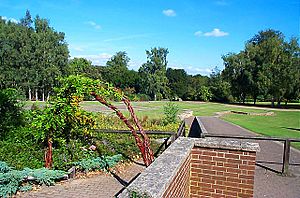Shipley Hall facts for kids
Quick facts for kids Shipley Hall |
|
|---|---|

Shipley Hall in the 1890s
|
|
| General information | |
| Town or city | Derbyshire |
| Country | England |
| Coordinates | 52°59′37″N 1°20′55″W / 52.9937°N 1.3486°W |
| Completed | 1799 |
| Demolished | 1943 |
| Client | Miller Mundy family |
| Design and construction | |
| Architect | William Linley |
Shipley Hall was a large country house in Shipley, Derbyshire. It was near the towns of Heanor and Ilkeston. Today, the land where it stood is part of a fun Country Park.
Contents
A Look Back: Early History of Shipley Hall
The land around Shipley is very old. It was even mentioned in the Domesday Book, a famous survey from 1086. For hundreds of years, starting in the 1300s, the area was a big forest. People used it for hunting, and there was a special hunting house on Shipley Hill.
Around the 1500s, people started digging for coal on the land. This helped the owners make money. Shipley Hall was first built in 1700. By 1722, coal mining was a very important activity there.
The Miller-Mundy family later owned the Hall. Around 1765, they started running the coal mines themselves. A canal called the Nutbrook Canal opened in 1796. It helped move coal from the Shipley mine. The money from coal helped improve the estate a lot. The Hall was rebuilt in 1799. This is the building you see in the picture. William Linley designed it. The gardens were designed by William Emes, who learned from a famous garden designer named Capability Brown.
Shipley Hall in the 1800s
In the late 1800s, Alfred Edward Miller Mundy owned Shipley Hall. The coal mine made more and more money, especially after the Midland Railway opened nearby. People thought Miller Mundy was a very good boss for his time. He was very involved in how the mines were run.
More improvements were made to the estate. A modern dairy farm was built, along with a water tower to supply it. These were designed by W. E. Nesfield. The Hall itself was made twice as big. A cricket ground was also created. The special gatehouses and gates were designed by Sir Walter Tapper.
Captain Miller Mundy, a later owner, even hosted King Edward VII at one of his parties. This happened before World War I. The cricket ground, built in 1899, is still used today. It is home to the Shipley Hall Cricket Club.
Shipley Hall in the 1900s
After Captain Miller Mundy passed away, the Hall was sold. The Shipley Colliery Company bought it. This was the same company his family had started. The family moved out because the noise and pollution from the coal mine made living at the Hall difficult.
In 1948, the coal mines became owned by the government. This is called nationalised. The National Coal Board decided that Shipley Hall was too damaged. The ground had sunk because of the mining underneath. So, they decided to tear it down in 1943.
The Woodside and Coppice coal mines were closed in the 1960s. People thought they were not making enough money. This ended over 250 years of deep coal mining in Shipley. What was left were piles of waste, old buildings, dirty lakes, and many abandoned mine shafts.
Shipley Country Park: A New Beginning
In the late 1960s, Derbyshire County Council decided to create a special park. They wanted it to be a memory of the mining history in the area.
The National Coal Board cleaned up the land near the closed mines. They used a method called opencast mining between 1970 and 1974. For two years, they shaped the land, planted trees, and sowed seeds for fields. They also built things for the public to use. Shipley Country Park opened on May 26, 1976.
In the 1980s, the County Council made a decision that caused some debate. They agreed to let part of the park be used for a theme park. It was first called Britannia Park. That business closed quickly. The park then reopened as The American Adventure. The last version of this park closed in 2007. Parts of it have been taken down. The future of this area, which includes the old Woodside Colliery site, is still being decided.
Shipley Country Park has many things to do. It has a visitor centre, play areas for kids, and a garden for wildlife. You can go on nature walks, visit a cafe, and use paths for horse riding. You can also try geocaching, cycling, fishing, or jogging. There's even a Parkrun event. People enjoy bird watching, photography, picnics, and walking their dogs. The cricket club is still there too.



